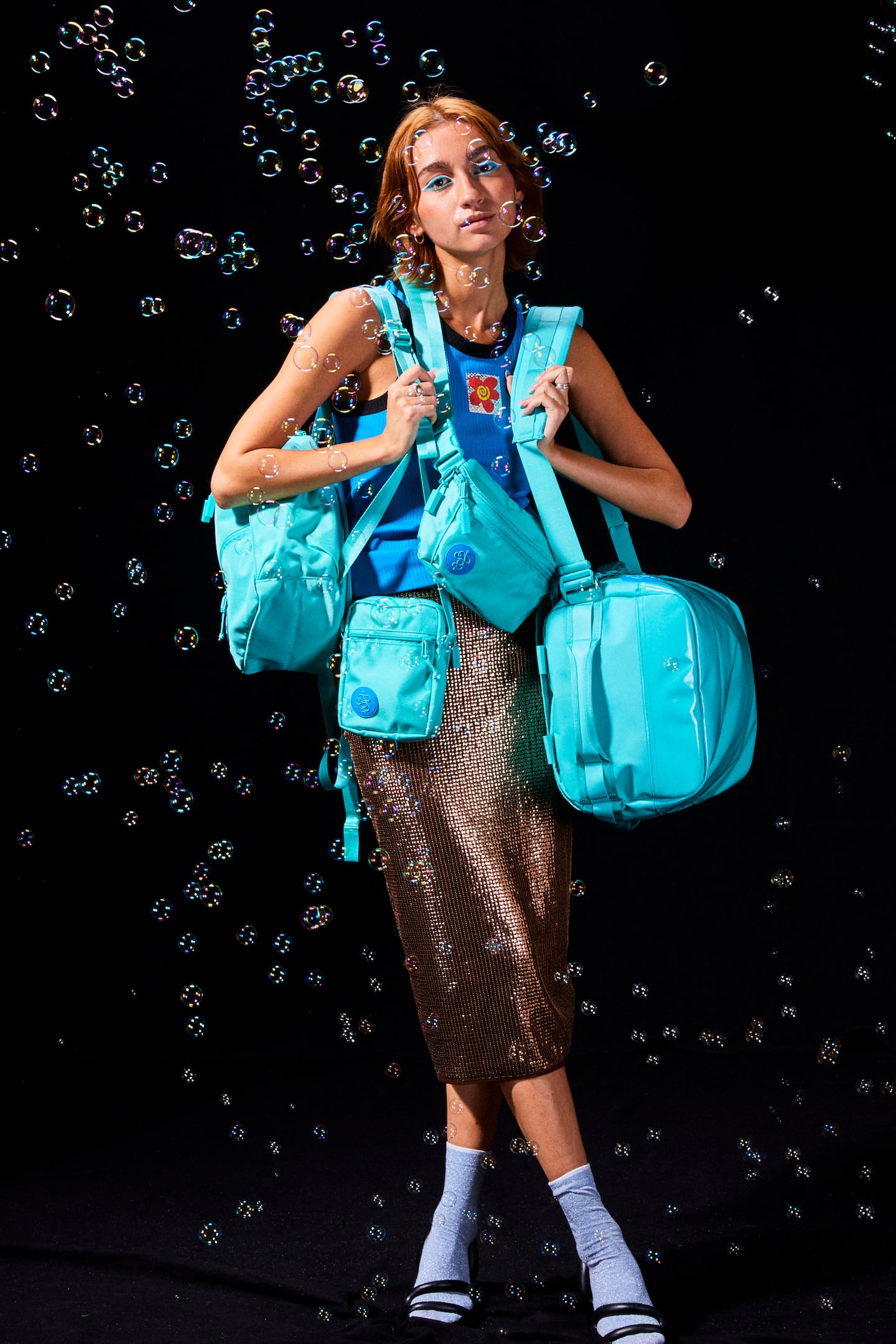
The Business of Fashion
Agenda-setting intelligence, analysis and advice for the global fashion community.

Agenda-setting intelligence, analysis and advice for the global fashion community.

This fall, Maya Thakrar, a 24-year-old recent graduate, booked a last-minute trip to Greece. Along with researching must-see sights and finding an Airbnb with the best view, she’s hunting for a new piece of luggage too.
Thakrar, who lives in New York City, bought an Away suitcase a few years ago, as the brand began to occupy a comfortable position in yearly ‘Best Of’ roundups. Last year, when looking for something new and novel, she picked up one of Baboon To The Moon’s colourful duffel bags after seeing it in TikTok.
Thakrar is part of the so-called revenge travel boom. Despite fears early in the pandemic that the travel industry would take years to recover, tourism is back with a vengeance: between April and July, travel spending in the US exceeded 2019 levels, according to the US Travel Association, a trade group.
Pent-up demand has created new opportunities for luggage brands, including direct-to-consumer entrants like Baboon To The Moon, July, Roam, Monos, and Béis that launched on the heels of Away’s success.
ADVERTISEMENT
Like Away, these newcomers are taking on established brands like Samsonite by targeting a younger consumer with sleek design and social media ads. But while Away dominated millennial mindshare with its $275 hard-shell carry-on in the late 2010s, this new generation of travel accessory brands are finding success with soft bags and other categories. They’re also exploring new ways of reaching consumers, whether that’s TikTok, wholesale or made-to-order personalisation.
But consumer interest in travelling allows for everyone in the market to benefit. Samsonite, which also owns American Tourister and Tumi, reported a 59 percent increase in sales in the first half of 2022 compared to the same period in 2021. LVMH-owned Rimowa “stepped up its performance considerably as borders reopened around the world” in the first half of 2022, the company said.
And Away, which struggled during the pandemic following allegations of a toxic work culture and a funding round at a lower valuation, is mounting a comeback. In the first two quarters of 2022, its sales increased 61 percent and 73 percent year-over-year, according to Earnest data. Recently, it launched a line of outdoor gear including duffel bags and convertible backpacks.
“The boom that everyone has been waiting for has happened,” said NPD industry analyst Beth Goldstein. “The challenge for new players, now, will be how to sustain it.”
For newcomers in the luggage category, crafting a unique value proposition is another way to target younger customers who expect a closer connection with the brands they consume.
Luggage company Roam is hoping to set itself apart from the competition by adopting a personalised made-to-order business model, where shoppers can choose the colours of the shell, zipper, and wheels of their suitcase online. Each personalised product is produced in American factories after a purchase has been placed.
“People don’t buy luggage every six months,” said Goldstein. “Brands are going to have to innovate and keep it fresh so they can continue to grow to reach new customers and retain the ones they already have.”
The hard-shell polycarbonate suitcase, for instance, is now a dime a dozen. Alongside Away, Roam, July and Monos all offer their own version of sleek plastic luggage. To continue driving sales, brands must offer other travel accessories too, such as weekenders, backpacks and duffels.
ADVERTISEMENT
“I’m not going to walk around New York with my Away luggage every single day,” Thakrar said. “I need to have an option that I can use every day, take on a flight and go on a trip.”
Away has found success with its new outdoor line, F.A.R., or For All Routes. The F.A.R. line will target a new set of consumers: hikers and outdoor enthusiasts, on top of its established base of travellers who prefer city trips with their spinner carry-ons.
“Through our research, we learnt that 52 percent of travellers expected their post-pandemic trips to be different,” said Laura Willensky, chief commercial officer at Away. “We pivoted our strategies to ensure we stay top of mind among our community.”
Away expects its outdoor line to account for upwards of 20 percent of its total business in the future.
Baboon To The Moon offers a slimmer selection of canvas bags, but builds multifunctionality into the product. Their best selling product is the Go-Bag: a duffel bag that can be converted into a backpack or sling bag and comes in an assortment of colours and a range of sizes, from carry-on appropriate to checked luggage.
“We want to meet young people where they are,” said Andy Person, founder and chief executive of Baboon To The Moon. “Be it a music festival, a hike or an international trip.”
More affordable pieces, like canvas duffels or weekenders, give brands a chance to acquire customers when they are young.
“Being able to scoop up consumers early will increase their likelihood of being a loyal customer in the long-term,” said Sarah Willersdorf, the global head of luxury at Boston Consulting Group.
ADVERTISEMENT
The first generation of direct-to-consumer brands like Warby Parker and Away struck gold with cheap ads on social media. Though the cost to advertise on some of these channels today has skyrocketed, it’s still an effective way to acquire customers. The savviest new entrants, however, are leveraging TikTok too, reaching a brand new set of shoppers.
Caleb Anderson, a 26-year-old who spends his time between Paris and New York City, said he was enticed by the brand Paravel after his Instagram feed was flooded with their advertisements for weeks.
“Those ads followed me everywhere,” Anderson said, “When I got to learn a bit more about them, their commitment to sustainable travel attracted me.”
Baboon To The Moon, on the other hand, has focused its efforts on TikTok, where the brand collaborates with up-and-coming influencers who promote their own bag designs on the platform. The company has a specific customer profile: a disoriented yet hopeful 24-year-old going through life with Baboon To The Moon’s vibrant, whimsical products.
Sarah Tang, a content creator for Baboon To The Moon, often serves as the face of the brand on TikTok. The 25-year-old would use the account as a video diary, detailing moments of her day which include pulling pranks on other employees, running errands using the brand’s product offerings or answering customer questions in a stylised and informative manner.
“TikTok as a platform provided a more informal and less filtered channel to communicate,” said Person. “Sharing images of products is easy, but sharing your brand personality is much more layered and TikTok really allows us to pull the curtain back on our view of the world, on our humour, and our quirkiness.”
The new generation of luggage brands are betting big on retail — something that their direct-to-consumer predecessors were slower to embrace. (The industry stalwart Samsonite, after all, still operates nearly 1,000 stores worldwide and can be spotted in every Macy’s.)
Some new brands incorporated wholesale into their business models from the start. Monos, founded in 2018, partnered with Nordstrom in October 2021.
“It is very important for us to have brand alignment with a department store,” said Victor Tam, co-founder and chief executive of Monos. “For us, the goal with wholesale is brand and marketing instead of pure revenue.”
The Melbourne-based July, also founded in 2018, opened a flagship in its hometown in August 2019. The company plans on opening new locations in North America and Europe in the coming years. Feedback from its store now informs July’s product design process.
“We use our store for market research and the amount of insight we get from our customers in real time helps us make a better product,” said Athan Didaskalou, the brand’s founder and chief strategy officer.
The nature of the luggage market has not changed much in the past 20 years and still relies heavily on physical retail, according to Willersdorf. “It may be difficult for a brand to scale without a lucrative physical presence,” she added.
The company is looking for a comeback after revenue declined by 50 percent to roughly $135 million in 2020, according to The Information. New chief
Three years after LVMH acquired the hardside luggage maker, Chief Executive Alexandre Arnault aims to move the brand beyond the baggage carousel and hit €1 billion in sales, all while building a ‘case study’ for a new way of working.

Yola Mzizi is the Editorial Apprentice at The Business of Fashion (BoF). She is based in New York and provides operational support to the New York team and writes features for BoF and The Business of Beauty.
The company, under siege from Arkhouse Management Co. and Brigade Capital Management, doesn’t need the activists when it can be its own, writes Andrea Felsted.
As the German sportswear giant taps surging demand for its Samba and Gazelle sneakers, it’s also taking steps to spread its bets ahead of peak interest.
A profitable, multi-trillion dollar fashion industry populated with brands that generate minimal economic and environmental waste is within our reach, argues Lawrence Lenihan.
RFID technology has made self-checkout far more efficient than traditional scanning kiosks at retailers like Zara and Uniqlo, but the industry at large hesitates to fully embrace the innovation over concerns of theft and customer engagement.